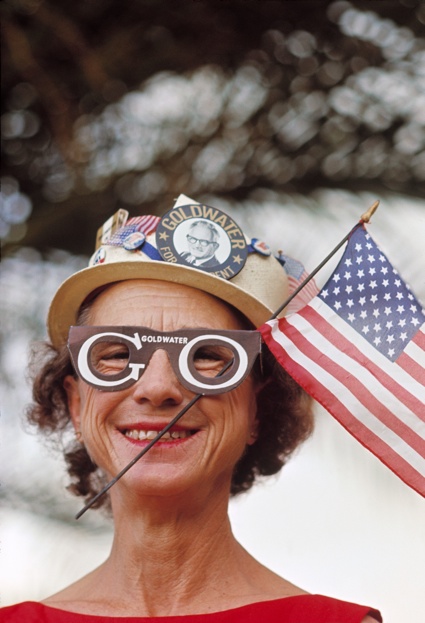 Supporter of Barry Goldwater presidential candidate, USA, 1964. © Eve Arnold / Magnum Photos
Supporter of Barry Goldwater presidential candidate, USA, 1964. © Eve Arnold / Magnum Photos
On Thursday i was in Turin and visited For President at the Fondazione Sandretto Re Rebaudengo. The timely, informative and a tad star-struck exhibition examines the American election campaigns, its calculated emotional moments, theatrical strategies and incestuous relationship with media. Part of the show is also looking at the interest Italy (and with it, the rest of Europe) is having for the American event, from a very brief article on page 3 of a daily newspaper in 1868 to the current front pages.
Starting from John Fitzgeral Kennedy, the first president to have reached the rest of the world through television, For President retraces the history of the different election campaigns, all having relied on photojournalism, contemporary art and the widespread production of paraphernalia and advertising for the various candidates.
In the spaces of the Fondazione, the artists who were influenced by their own research on the elections mix their work with the iconic images of the agency Magnum.
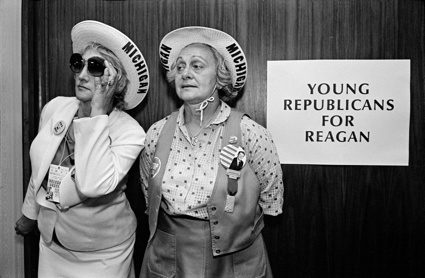 Republican Party National Convention. Young Republicans. Detroit, USA. 1980.
Republican Party National Convention. Young Republicans. Detroit, USA. 1980.
© Richard Kalvar / Magnum Photos
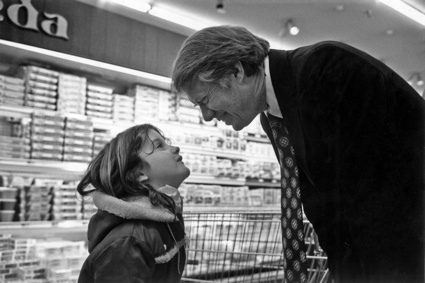 Former Governor of Georgia Jimmy Carter campaigning for the Democratic presidential nomination in the nation’s first primary election. New Hampshire, USA. 1976. © Richard Kalvar / Magnum Photos
Former Governor of Georgia Jimmy Carter campaigning for the Democratic presidential nomination in the nation’s first primary election. New Hampshire, USA. 1976. © Richard Kalvar / Magnum Photos
The first presidential debate between candidates from opposing political parties as well as the first one to be televised took place in 1960 between Senator John F. Kennedy and Vice President Richard Nixon. The event is now more famous for the TV appeal of the candidates than for the content of the debate. It has often been written that people listening to the discussion on the radio were convinced that Nixon had emerged victorious from the debate. Television audiences, however, thought Kennedy had decidedly won the debate. Nixon was recovering from a knee injury and from a demanding tour of every single State of the US, he had refused to wear makeup and appeared unhealthy and stiff. Kennedy, on the other hand, was tanned and looked directly at the camera with confidence. JFK’s suit was dark and contrasted well against the background. Nixon’s grey suit almost blended in with the background.
26 September 1960: Senator John Kennedy of Massachusetts vs. Vice President Richard Nixon
Polls later revealed that more than half of all voters had been influenced by the Great Debates, while 6% claimed that the debates alone had decided their choice. Most importantly, the four Kennedy-Nixon debates also heralded a new era in which media exposure became a key part of a successful political campaign and in which television played an important role in the democratic process.
Max Almy, Perfect Leader, 1983
Fast forward to 1984 and artists are satirizing the circus of politics on tv. Produced to coincide with the “Ronald Reagan vs Walter Mondale” Presidential Campaign, Perfect Leader is a virulent parody of media politics. A computer program is creating candidate archetypes — dictator, evangelist, moderate — before it blends them together to create the ultimate mass-marketed leader.
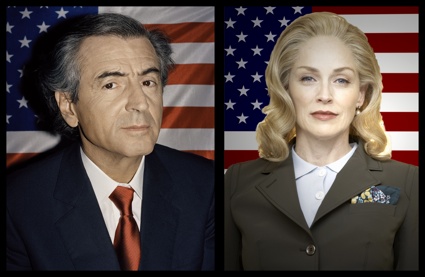 Francesco Vezzoli, Democrazy, 2007. Photo by Matthias Vriens
Francesco Vezzoli, Democrazy, 2007. Photo by Matthias Vriens
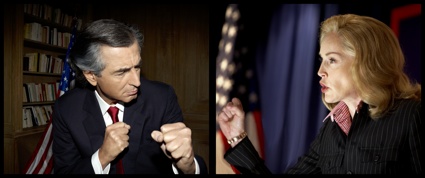 Francesco Vezzoli, Democrazy, 2007. Photo by Matthias Vriens
Francesco Vezzoli, Democrazy, 2007. Photo by Matthias Vriens
The Democrazy video installation screens two political ads for a fictional presidential campaign. The two candidates are Patricia Hill (played by Sharon Stone) and Patrick Hill (played by French philosopher Bernard-Henri Lévy). The ads were produced in collaboration with political experts, Sharon Stone’s ad was supervised by one of George W. Bush’s media advisors in 2004, and Levy’s by a member of Bill Clinton’s creative team in 1996.
The political ads feature every political cliché in the book. Every move and expression is studied. Both candidates talk about peace, international politics and future of the country. They kiss children, smile broadly, wear impeccable haircuts and it is almost impossible to make out any differences in their programs.
The short videos demonstrate that the rules of election campaigns are increasingly similar to the ones governing the world of entertainment and show business. The obvious examples being Ronald Reagan and Arnold Schwarzenegger. A situation which strikes a chord in Italy where media tycoon Silvio Berlusconi might even come back for another round as a Prime Minister.
The film also demonstrates that the political discourse is no longer anchored in argumentation, logic, nor even in content but in the image filtered through the media. And in particular on television, the main arena of political confrontation.
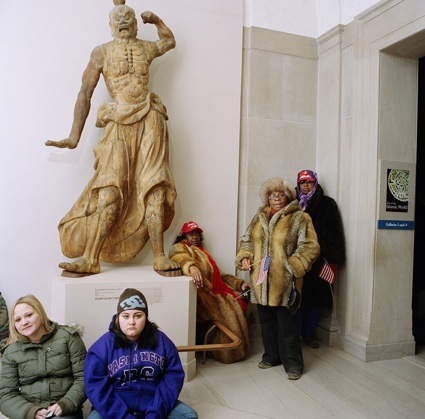 Ramak Fazel, Smithsonian Freer Gallery, Washington, January 20th 2009, 2009
Ramak Fazel, Smithsonian Freer Gallery, Washington, January 20th 2009, 2009
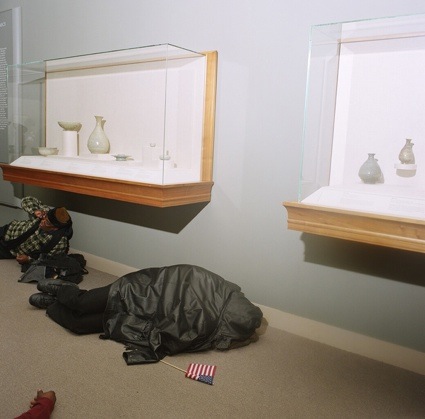 Ramak Fazel, Smithsonian Freer Gallery, Washington, January 20th 2009, 2009
Ramak Fazel, Smithsonian Freer Gallery, Washington, January 20th 2009, 2009
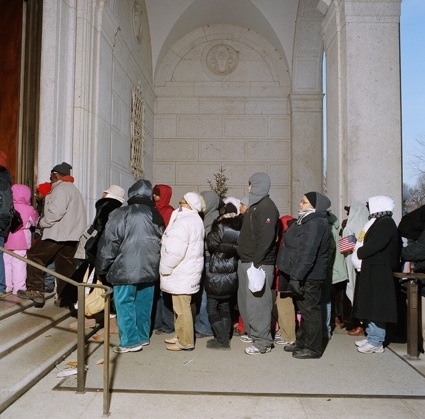 Ramak Fazel, Smithsonian Freer Gallery, Washington, January 20th 2009, 2009
Ramak Fazel, Smithsonian Freer Gallery, Washington, January 20th 2009, 2009
Most of the works in the entrance hall featured the president Europeans like so much: Barack Obama. There were large-scale portraits, images from the current campaign as well as a photo series -by Ramak Fazel- that showed another aspect of the few hours that preceded the inauguration of Obama on January 20, 2009. Surprised by a storm while waiting for the appearance of the President, people had to take refuge in the Smithsonian Freer Gallery where they quickly lost interest for the art works and used the museum to rest and shelter against the elements.
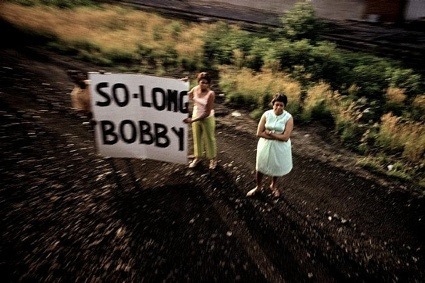 Paul Fusco, Robert Kennedy funeral train, USA, 1968
Paul Fusco, Robert Kennedy funeral train, USA, 1968
Most of the works shown at the Fondazione were image shot by photographers working for Magnum. The most moving series was Paul Fusco’s Funeral Train.
In 1968, Fusco accompanied the funeral procession that transported the body of Robert Kennedy from New York City to its final resting place in Washington. Traveling by train, the coffin was elevated so that the public could see it through the large windows of the carriage. However, Fusco photographed the mourners who were waiting and standing silently by the track to pay their respects.
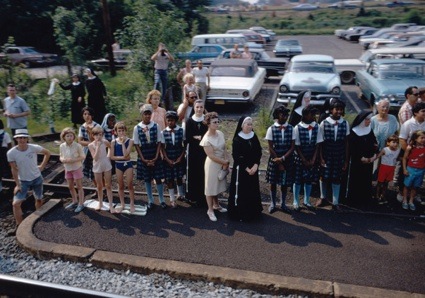
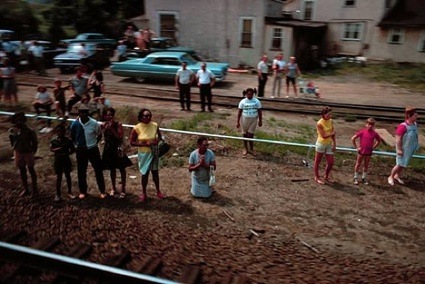 Paul Fusco, RFK Funeral Train No. 2598, 1968
Paul Fusco, RFK Funeral Train No. 2598, 1968
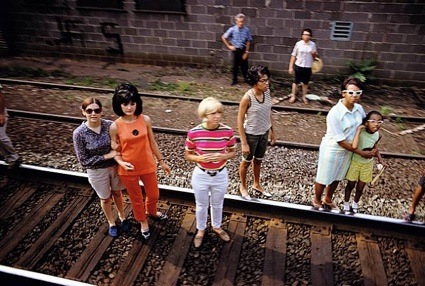 Paul Fusco, Untitled from RFK Funeral Train Rediscovered, 1968
Paul Fusco, Untitled from RFK Funeral Train Rediscovered, 1968
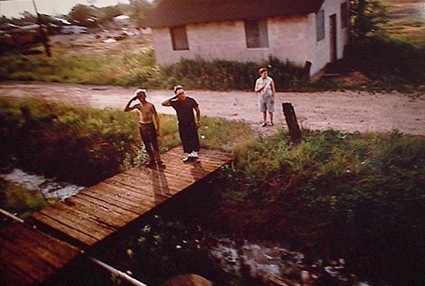 Paul Fusco, RFK Funeral Train No. 1706, 1968
Paul Fusco, RFK Funeral Train No. 1706, 1968
And in no particular order (well, except the first one because Carter has always been my favourite.)
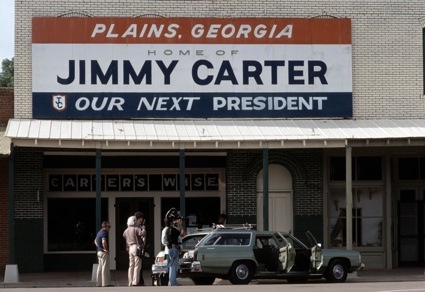 Alex Webb, Jimmy Carter campaign billboard, Plains, Georgia, 1976
Alex Webb, Jimmy Carter campaign billboard, Plains, Georgia, 1976
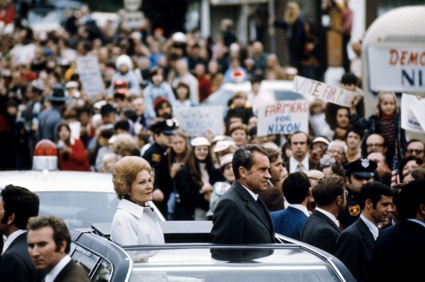 © Hiroji Kubota / Magnum Photos
© Hiroji Kubota / Magnum Photos
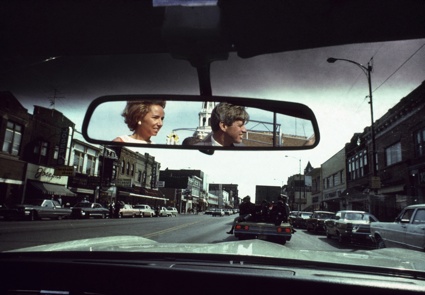 New York state senator Robert Francis Kennedy campaigning in a small town. Indiana, USA. 1968. © Burt Glinn / Magnum Photos
New York state senator Robert Francis Kennedy campaigning in a small town. Indiana, USA. 1968. © Burt Glinn / Magnum Photos
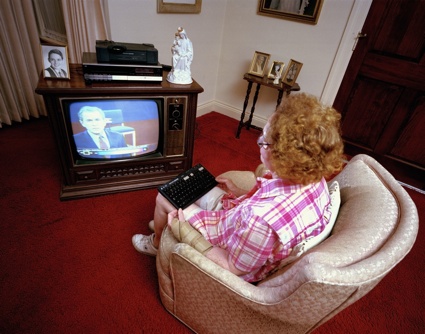 Marion Frost, an elderly American woman, watches the 2000 presidential debates between George W. Bush and Al Gore. San Maro County, California, USA. 2000. © Jim Goldberg / Magnum Photos
Marion Frost, an elderly American woman, watches the 2000 presidential debates between George W. Bush and Al Gore. San Maro County, California, USA. 2000. © Jim Goldberg / Magnum Photos
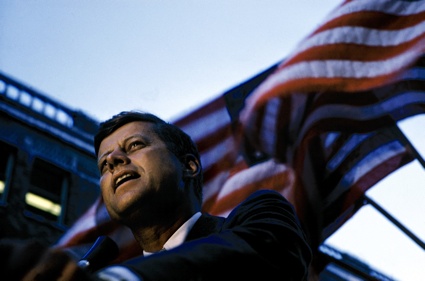 John F. Kennedy campaigning for president. USA. 1960. © Cornell Capa / International Center of Photography
John F. Kennedy campaigning for president. USA. 1960. © Cornell Capa / International Center of Photography
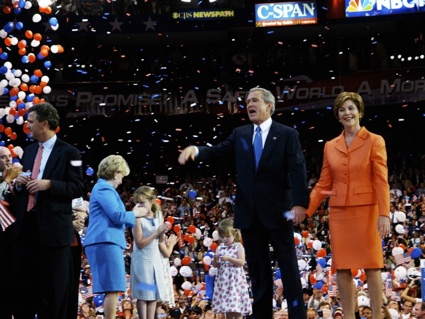 George W. and Laura BUSH, New York City. September 2, 2004. © Eli Reed / Magnum Photos
George W. and Laura BUSH, New York City. September 2, 2004. © Eli Reed / Magnum Photos
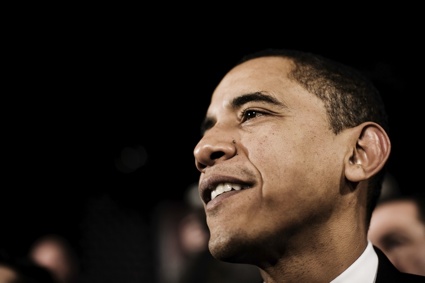 Barack Obama at a rally, Salem, New Hampshire, USA, 2008. © Christopher Anderson / Magnum Photos
Barack Obama at a rally, Salem, New Hampshire, USA, 2008. © Christopher Anderson / Magnum Photos
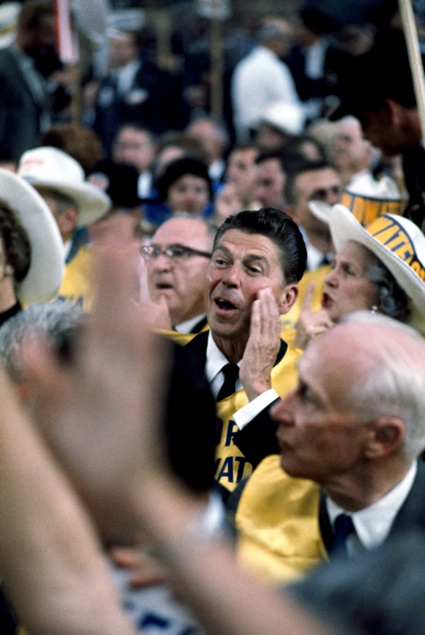 Ronald Reagan at the Republican National Convention. California, USA, 1964. © Burt Glinn / Magnum Photos
Ronald Reagan at the Republican National Convention. California, USA, 1964. © Burt Glinn / Magnum Photos
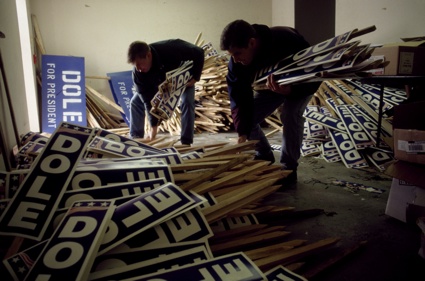 Banners for the New Hampshire State’s Primary elections Robert Dole. New Hampshire, USA. 1996. © Paul Fusco / Magnum Photos
Banners for the New Hampshire State’s Primary elections Robert Dole. New Hampshire, USA. 1996. © Paul Fusco / Magnum Photos
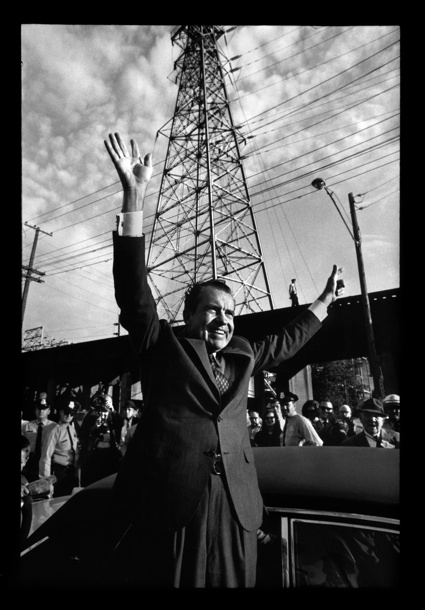 Presidential campaign. American candidate Richard Nixon. Louisville, Kentucky, USA, 1968. © Raymond Depardon / Magnum Photos
Presidential campaign. American candidate Richard Nixon. Louisville, Kentucky, USA, 1968. © Raymond Depardon / Magnum Photos
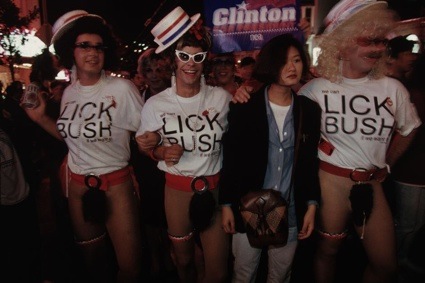 Paul Fusco, Halloween on Castro Street, San Francisco, 1992. © Paul Fusco/Magnum Photos
Paul Fusco, Halloween on Castro Street, San Francisco, 1992. © Paul Fusco/Magnum Photos
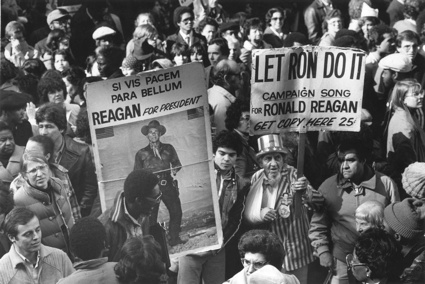 Rene Burri, Election campaign for Ronald Reagan, New York City, 1980
Rene Burri, Election campaign for Ronald Reagan, New York City, 1980
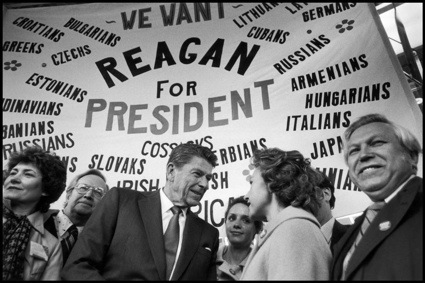 Gilles Peress, Ronald Reagan campaigning, 1980
Gilles Peress, Ronald Reagan campaigning, 1980
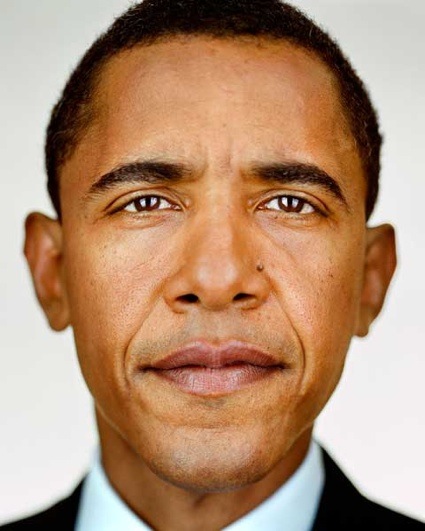 Martin Schoeller, Barack Obama, 2004
Martin Schoeller, Barack Obama, 2004
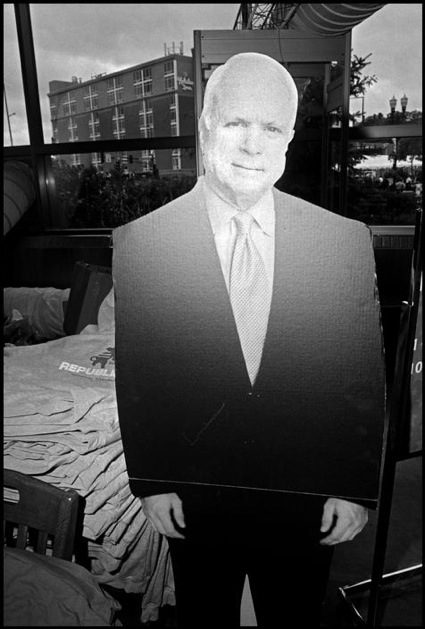 Bruce Gilden, Cardboard cutout of John McCain, Republican National Convention, Saint Paul, Minnesota, USA, September 2008
Bruce Gilden, Cardboard cutout of John McCain, Republican National Convention, Saint Paul, Minnesota, USA, September 2008
For President was curated by Francesco Bonami and Mario Calabresi. The former is an international art critic, curator and the current artistic director of the Fondazione Sandretto Re Rebaudengo (where he does a fantastic job.) The latter is the director of the Turin-based newspaper La Stampa. A large room at the Fondazione was dedicated to the space that La Stampa has allocated to the presidential elections since it was founded (under the name La Gazzetta Piemontese) in 1866.
The first mention of the US elections was a short article on page 3 of the Italian newspaper to announce the election of Grant as president of the U.S.A. At the time, Italian newspapers were more interested in what what happened in France, Prussia, London or in the Ottoman Empire.
Throughout the 19th century, news from the other side of the Atlantic came by telegraph through the submarine cable that ran across the Ocean. The first time an election received a whole issue was in 1928, with the victory of Herbert Hoover. Under Fascism the gap between Italy and the Atlantic widened again, to the point that in 1936 the re-election of Roosevelt was confined to page 8.
The first front page for the US election came with the election of Eisenhower. Photo, maps and charts, however, only appeared in 1960 when John F. Kennedy conquered the White House. Since then Italians have been never ceased follow with passion the American elections.
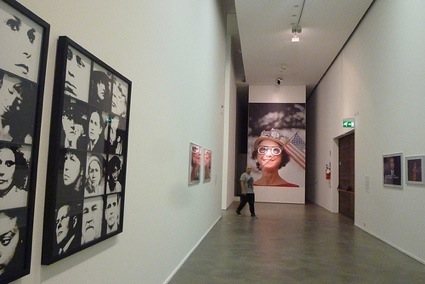
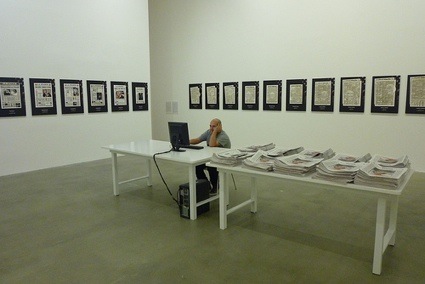
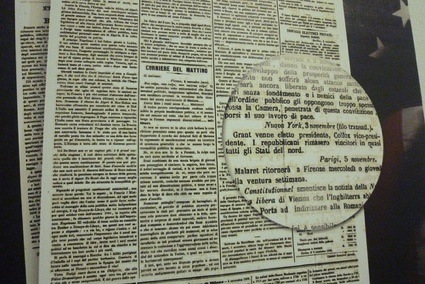
A few shots from the show:
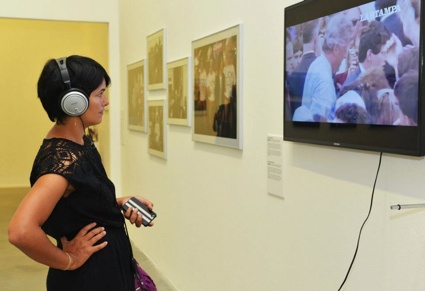 View of the exhibitions space (photo)
View of the exhibitions space (photo)
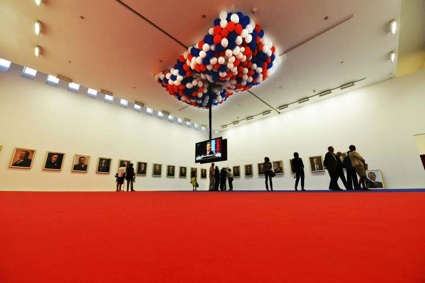 Jonathan Horowitz, Obama ’08, installation view, 2008 (photo)
Jonathan Horowitz, Obama ’08, installation view, 2008 (photo)
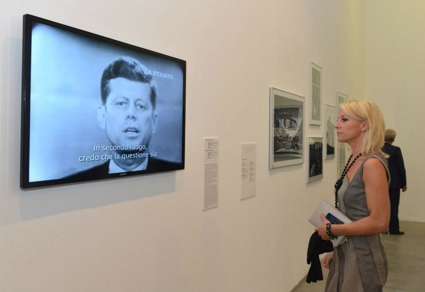 View of the exhibition space (photo)
View of the exhibition space (photo)
For President, an exhibition curated by Mario Calabresi and Francesco Bonami, remains open at the Fondazione Sandretto Re Rebaudengo in Turin until 6 January 2013.
